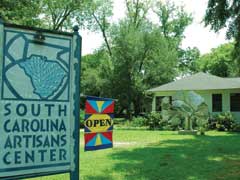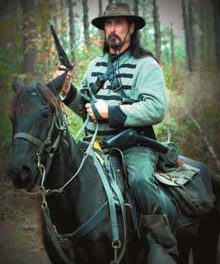The Backyard Tourist (Mark Shaffer) at Loggerheads
Loggerhead Fact: Only 1 out of 1000 loggerhead hatchlings will make it to sea. Perhaps just 1 in 10,000 will survive to maturity.
Friday, July 24, 2009
Just before dawn, approaching the main gate of Hunting Island State Park, a small silhouette darts across the road ahead of us. Then something else – something bigger, slower, harder to make out – follows the first shadow. If the headlights hadn’t caught a brief reflection of an eye in the near pitch black, we’d probably be upside down in the marsh right now with most of the Honda’s front end on the road with the gator. Fortunately for all of us Susan pumps the brakes when the young raccoon darts across the road. The seven foot-long reptile lumbers up out of the marsh right behind him, utterly oblivious to the road, the car or the lights. Wet from a swim in the marsh, his black hide glistens. The first amber rumor of the dawn spreads across the low-lying clouds to the east adding to the surreal nature of the scene ahead. Our reptilian speed bump moseys over the asphalt at a decidedly unhurried pace – quick enough, however, to vanish into the brush before I manage to dig out my camera for a shot. Memo to self: keep camera handy on these excursions; drink more coffee.
I’ve no need for more coffee just now. This adrenaline rush will do quite nicely, thanks. The alligator is gone. The road is ours and the sun is about to rise over the beach revealing the secrets of the night and a genetic ritual old as the sand. But I’m getting ahead of myself.
Loggerhead Fact: Sex is determined in the nest by temperature: hot spots produce females while cool spots produce males (hot mamas & cool daddies). 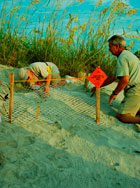
To say that Karen Whitehead is passionate about turtles is like calling healthcare reform “a mildly divisive issue” or Lowcountry summers “a bit tepid.” She is quite simply mad about turtles, the loggerheads of Hunting Island in specific. This seems appropriate for the Director of the Loggerhead Sea Turtle Rescue Program, which is part of the park’s remarkable volunteer support organization. In fact, the non-profit Friends of Hunting Island (FOHI) literally hatched with the genesis of the turtle program back in 1993. Now nearly 800 members later, FOHI is an indispensable part of Hunting Island’s daily operations and fiscal well-being. “They make things happen that might not happen without them,” says Park Manager, Jeff Atkins (read the accompanying interview for more). Wendy Pollitzer, the park’s Interpretive Program Manager, echoes that thought. “They do all the hard work,” she says. “We just don’t have the staff, the time or the money to do this program without them.” Pollitzer also serves as the conduit through which the data gathered by FOHI flows to the SC Department of Natural Resources, which tracks and compiles the information to better understand native turtle populations.
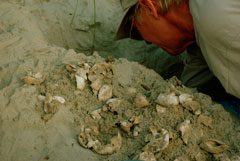 Among its many awards, FOHI has received the prestigious Take Pride in America Award by the U.S. Department of the Interior, for the Loggerhead Sea Turtle Rescue Program, Dune Building, & Oyster Reef Restoration Programs. Clearly, they’re doing something right and from May through August this means watching over the turtles and their nests seven days a week.
Among its many awards, FOHI has received the prestigious Take Pride in America Award by the U.S. Department of the Interior, for the Loggerhead Sea Turtle Rescue Program, Dune Building, & Oyster Reef Restoration Programs. Clearly, they’re doing something right and from May through August this means watching over the turtles and their nests seven days a week.
“They mostly come up at night,” says Karen. “We look for the tracks in the morning. They’re hard to miss.” A buoyant, graceful animal in the sea, she is quite the opposite on dry land. At around 250 pounds, the female leaves a trail, ironically enough, like an amphibious vehicle as she hauls her great bulk up the beach in search of a nesting site. If she finds what she’s looking for, she scoops out a light bulb-shaped hole in the sand with her rear flippers. No one’s quite sure how she manages this, but she does nonetheless, fashioning a kind of narrow chute that opens up into a larger chamber for the eggs. Once she’s deposited and covered her clutch, she returns to the sea, the fate of the nest and its living treasure left to Nature and a dedicated group of sleep-deprived volunteers battling vampiric insects on the beach in the name of conservation. During the laying season FOHI volunteers gather every morning to comb the beach to look for signs of activity and gather data. Each day belongs to a different bunch. They gather in the predawn dark at the Visitor Center for a briefing on the previous day’s activities, pick up radios and supplies and break up into individual groups assigned to inspect one of the island’s six zones.
For everything there is a procedure, particularly with a threatened species. “If the nest is above the high tide mark we usually leave it in place, just cover or screen it or cage it,” says Karen. These measures help to keep out predators like ghost crabs and raccoons. An actual nest sight is determined with careful probing by a trained and certified volunteer. Nests too near the tide lines, or in danger zones are moved, a painstaking and delicate process that involves disturbing the eggs as little as possible, as quickly as possible. “We have a 12 hour window when we can actually move the eggs,” says Karen, “after that the embryo’s attached, so we don’t want to disturb that or we destroy the turtle.”
After the nests have had time to incubate, volunteers look for signs of hatching, anything from a single track leading out of the nest to the mass exodus called a “boil.” Once a nest has begun to hatch it’s allowed three days to complete the cycle before being inventoried, yet another delicate process of excavating the nest and tallying the results. Some inventories are better than others.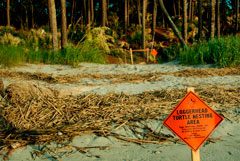
Loggerhead Fact: According to U.S. Fish and Wildlife studies, adults reach sexual maturity at around 30 years of age. Mature females may lay as many as 7 clutches in a season averaging around 130 eggs per clutch.
Tuesday, July 21st, 2009
Our first turtle patrol with the Friends of Hunting Island. My wife, Susan is along to assist (as usual) and observe what she’ll be doing once she’s certified to join the group. Our friends Lolita and Jon are part of the Tuesday patrol, but we’re off in different directions once Karen adjourns the morning briefing. They draw Zone 1 on the north end of the island, we tag along with Karen to Zone 3 near the Lighthouse and a recent hotbed of activity.
A blaze of orange fire filters through the line of billowing white clouds on the horizon. Freshly steeped in the nautical fiction of Patrick O’Brien I half expect to hear the distant crash of cannon fire and catch site of tall masts riding above what surely must be gun smoke. Boats do appear on the horizon, but no marauding corsairs or ships of the line. My brief reverie evaporates. Local shrimpers parallel the shore, silhouetted by a pale orange sun. The reflection off the water has us sweating in minutes in spite of the constant sea breeze. This is perfect exposure for nesting turtles. 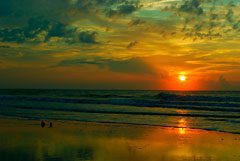
More than a dozen nests are visible near the edge of the maritime forest by the Lighthouse, one just yards away from the volleyball net. Each is clearly marked with a bright orange sign and protected by a mesh enclosure designed to keep predators out, but allow the hatchlings to escape.
We follow Karen down the beach – not an easy task – as she zigzags between the nests for any signs of hatching or predation. Essentially we’re looking for really big turtle tracks coming from the sea and very, very small ones leading out of the nests and toward the water. Not much luck this morning, at least on our end. Up the beach Lolita radios that a nest has hatched. They’ve rescued a single straggler who’s apparently on his way to the Gulf Stream. Meanwhile, some of our group’s got something up ahead: turtle tracks leading past the tide line to a possible nest. Careful and methodical probing reveals no nest, but a probable explanation for this “false crawl.” About six inches below the surface the sand is hard packed and nearly impenetrable, the result of past beach re-nourishment efforts. Just a few yards further other turtles, perhaps even this one, found softer sand. There may also be another reason she didn’t continue – raccoons. There are tracks all around the area she tried to excavate, possible evidence that she may have been harassed before she could even dig a nest. 
Loggerhead Fact: Once a male loggerhead leaves the nest he will live out his entire life – perhaps a century or more – at sea, returning to land only if sick or injured.
Wednesday, July 22nd, 2009
Sometime during the night the power surges. This apparently scrambles the little electronic brain of our supposedly “fail safe” alarm clock, which it turns out is decidedly not. Naturally, this is the busiest day in weeks with four new nests, one hatching, a nest relocated due to predation and an inventory.
We set multiple alarms that night. 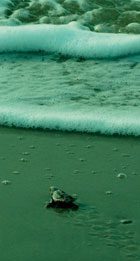
Loggerhead Fact: One quarter of all loggerhead nesting in the U.S. occurs along a 20 mile stretch of Florida’s Archie Carr National Wildlife Refuge, considered the most important nesting area for the turtles in the Western Hemisphere.
Thursday, July 23rd, 2009
No alarm malfunctions this morning. We’re back in Zone 3 at daybreak as the team confirms a pair of false crawls. There is no sign of an attempt to dig a nest at one site. Don Berg probes a possible nest at the second crawl. Nothing. He marks the tracks with an “X.”
We drive around to the campground for an inventory training session with Karen. The nest is near the bathhouse and it appears to have suffered a wash-over at some point. Even for a neophyte like me this doesn’t look promising. And yet the nest has hatched, all that remains is to determine the ratio of success. Karen goes through each aspect of the procedure for the gathered volunteers. It’s all very careful, a little complicated and designed to ultimately provide information that may aid in the survival of the species.
Jessy Wayles with the park’s Nature Center assists Karen with the inventory, carefully scooping out the nest by hand, keeping careful count of the contents, anticipating the possibility of a live hatchling or two, prepared a few who didn’t make it. The group moves in tight to get a closer look. A collective grimness settles over us as the little piles of intact eggs begin to add up. Thankfully, there are no dead hatchlings. There are no live ones, either (always a bonus for this kind of work).
The numbers for this nest are not great: 64 hatched, 60 un-hatched. I learn later that this was nest number 1, the first of the season, laid on Mother’s day.
Loggerhead Fact: When driving to Hunting Island in the pre-dawn hours to search for loggerhead nests one must take care to avoid conflicts with the indigenous wildlife.
Friday, July 24th, 2009
Having successfully avoided the dubious fate of becoming the only car-versus-alligator fatalities on Hunting Island in quite possibly ever, we move on to another nest inventory near the campground. This one’s drawn a pretty good crowd. In fact there’s a sort of giddy buzz in the air. Not at all like yesterday.
Just 50 yards or so up the beach from that disappointment, I’m told this nest is nearly textbook perfect. This part of the beach offers gently sloping dunes, and soft, warm sand lush with sea oats. The turtle dug out her nest about midway up the dune, far beyond any recent tidal line. There is evidence of a “boil.” Dozens of sets of miniature turtle tracks, like tiny model tanks, trail down the side of the dune. There is no sign of predation.
Once again Karen goes through all the procedures, covering the count, paperwork, egg disposal, live turtle release and crowd control. “Now we get to the good stuff,” she says and begins to dig. After what seems like an eternity, she begins to pull up fistfuls of hatched eggs and relatively few misfires. Out of 138 eggs, 125 have hatched – stellar numbers by loggerhead standards. “That’s about as good as it gets,” observes Wendy. And there’s the bonus every volunteer hopes for during an inventory. At the bottom of the nest Karen discovers two live hatchlings. These little guys have survived under two feet of sand for the better part of three days – a small miracle and the first of many they’ll need on the perilous journey on which they’re about to embark.
Lines are drawn in the sand to give the youngsters room to make it to the water. This is a first for many of us, a unique experience we’ll not soon forget and one that sparks a few sobering thoughts. As I watch these tiny, fragile creatures struggle toward the surf I’m struck by the shear odds they face to survive, odds that would terrify any professional gambler. But there’s something else. Should either of these animals beat those odds and return to continue this timeless cycle, most of us here on this beach today won’t be around. In fact, should she live a relatively average life for her kind, perhaps the better part of a century or more, one day her own offspring may be cheered on by the grandchildren of some of these kids cheering her on. Why not? Anything’s possible, right? 
The volunteers and onlookers disperse. A camper rolls his cart packed with fishing gear and a cooler up the beach toward The Point where the Harbor River meets St. Helena Sound. The early morning sun moves behind a thin veil of cloud, diffusing all color like a photographic filter, transforming the water to shimmering mercury. In the thick salty air on the shores of a molten sea, I imagine the turtles and make a wish.
For more information on Hunting Island, the Sea Turtle Rescue Program and how to get involved visit www.friends-of-hunting-island-sc.org and track turtle progress at www.seaturtle.org.
Mark Shaffer’s email address is backyardtourist@gmail.com.

